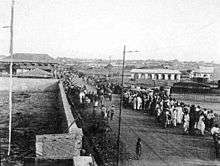Homowo

Homowo is a festival celebrated by the Ga people of Ghana. The festival starts in the month of May with the planting of crops before the rainy season starts. During the festival, they perform a dance called Kpanlogo. The Ga people celebrate Homowo in the remembrance of the famine that once happened in their history in precolonial Ghana.
Etymology
The word Homowo (Homo - hunger, wo - hoot) can mean "to hoot" or "to jeer at hunger" in the Ga language.[1] The tradition of Homowo started with a period of hunger leading to famine due to failure of the seasonal rains needed by crops in the Greater Accra Region, where the Ga people predominantly dwell. When the rains returned to normal, the Ga people celebrated by creating the Homowo festival, hence its name and meaning. Homowo is greatly celebrated in all the towns in the Ga state with celebrations climaxing in Gamashie. The celebration begins with the planting of maize, which will be used in preparing the food for the festival named Kpokpoi or Kpekple. During this period, noise making is prohibited since it is believed that it will hinder the maturity of the crop. The meal is eaten with Palm Nut Soup and it is also sprinkled within the town. This is normally done by the fetish priest. Celebration includes marching down roads and streets beating drums, chanting, face painting, singing and traditional dances. On this day there is usually a lot of traffic and roads are usually blocked off to accommodate the festival. Even though it is a Ga tradition, many other ethnic groups are welcomed to also join in the celebration.
See also
References
- ↑ The Library of Congress's article on Homowo. Retrieved 08 September 07
